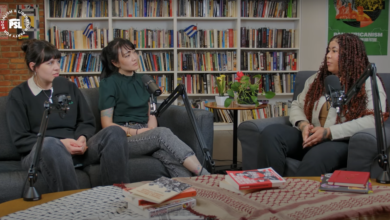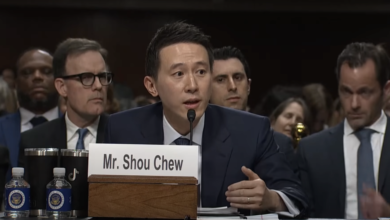The writer is the national staff coordinator for the ANSWER Coalition (Act Now to Stop War and End Racism) and a member of the Party for Socialism and Liberation. She will be reporting for PSLweb.org on protests taking place during the fifth round of KorUS FTA negotiations in Big Sky, Montana, Dec. 4-8.
Sentiment against the bilateral free trade agreement currently being negotiated between the U.S. and South Korean
|
On July 10, over 100,000 Korean workers, farmers and others marched in Seoul during the second round of KorUS FTA negotiations. In October, negotiators moved their negotiations from the South Korean capital to Jae Ju Island—60 miles from the southern tip of the Korean peninsula. But they could not escape militant protests that took place outside the negotiations.
A series of protests have been taking place in November and are planned for December to continue the struggle.
On Nov. 15, 138,000 workers in South Korea went on strike. They were responding to a call from the Korean Confederation of Trade Unions (KCTU), which called for a four-hour warning strike in preparation for the 2006 General Strike. On Nov. 22, over 200,000 workers participated in the full-fledged General Strike.
KCTU is a member of the Korean Alliance Against the Korea-U.S. FTA (KoA), a coalition of 280 organizations that has been spearheading the struggle against the KorUS FTA. One of the central demands of the strike actions was to stop the negotiations for the KorUS FTA.
On Nov. 22, anti-FTA protests were held in 17 cities in South Korea, involving tens of thousands of people. In their newsletter, KoA wrote that “the Mass People’s Resistance against the KorUS FTA began.”
KoA also responded to media and government attacks on the demonstrations: “The government, which has always ignored the outcry against the FTA, now claims the farmers and workers are holding ‘violent’ protests for no reason at all, as if it is not obvious that the people of Korea have many reasons to protest. … The government and the mainstream media together do not report why the farmers and workers are fighting. Instead they paint a distorted image of those who protest as simply violent criminals.”
Mass actions against the FTA were called for Nov. 29 and Dec. 6.
On Nov. 29, thousands of people participated in protests that took place in Seoul and several other South Korean cities, despite a refusal to grant permits to demonstration organizers and attempts by police to prevent people from accessing the protests.
Repression intensifies
Following the Nov. 22 protests, the South Korean government raided KoA offices around the country, issued warrants for the arrests of demonstration leaders and banned all protests against the KorUS FTA.
On Nov. 29, over 50,000 police were sent around the country to block people from accessing demonstrations, including 13,000 police stationed at over 1,000 locations leading to Seoul. Police buses were used to block off the Seoul City Hall Plaza where many massive demonstrations gather.
This level of repression against an organization that represents the sentiment of the majority of people in South Korea is a manifestation of the semi-colonial relationship that exists between the United States and South Korea.
U.S. troops entered South Korea in 1945 following the surrender of Japan in World War II. Japan had colonized the Korean peninsula at the end of the 19th century. The U.S. government insisted that the defeated Japanese troops maintain their posts for almost a month until the arrival of U.S. troops to prevent the Korean people south of the 38th parallel from taking control of their own country. Over 60 years later, 28,000 U.S. troops remain in South Korea.
The KorUS FTA, if completed, will be the largest free trade agreement since NAFTA. And its impact on workers and farmers in the United States and South Korea will be the same as NAFTA’s impact on workers and farmers in Mexico, the United States and Canada.
The U.S. government has talked about making the KorUS FTA the “gold standard” of FTAs. The code word for its real intentions is “comprehensive,” meaning there will be no exceptions. The U.S. government hopes that the FTA will tear down any existing barriers to U.S. economic domination of the South Korean economy.
The KorUS FTA is an extension of the policy that the United States has pursued in South Korea since 1945. It is an effort to impose a new type of economic colonialism on the country.
In response to the repression, KoA wrote, “This is the government repression that began on November 22nd and is continuing to spread like a forest fire. However, the people’s struggle to block the KorUS FTA will not end here. … Through our united struggle, the workers, farmers and common people of Korea will, without fail, stop the KorUS FTA.”
Protests during negotiations
For their fifth round of negotiations, U.S. and South Korean negotiators are meeting at a ski resort situated nine miles up a mountain in the tiny town of Big Sky, Montana.
They hoped that their remote location would remove the threat of protests like those that took place during the first round in June in Washington, D.C., and the third round in September in Seattle. But KorUS FTA opponents have vowed to protest wherever and whenever negotiations take place.
A week of protests from Dec. 4-8 was organized by KoA and KAWAN—Korean Americans Against War and Neoliberalism—a U.S. coalition of progressive U.S.-based Korean organizations endorsed by nearly 100 groups around the country. For a listing of planned actions, go to http://kawanlist.blogspot.com/.
A solidarity protest will be held in Washington, D.C., on Thursday, Dec. 7, at 5:00 pm at the White House. It is being organized by the D.C. chapters of KAWAN and the ANSWER Coalition.






